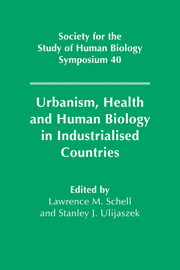Book contents
- Frontmatter
- Contents
- List of contributors
- Part I The urban environment
- Part II Epidemiology
- Part III Poverty and health
- 9 Urban poverty and nutrition in the United Kingdom
- 10 Poverty, nutrition and obesity in the USA
- 11 Nutritional status and its health consequences among low-income urban pregnant women: diet and environmental toxicants
- Part IV Behavior and stress
- Part V The future
- Index
10 - Poverty, nutrition and obesity in the USA
Published online by Cambridge University Press: 06 January 2010
- Frontmatter
- Contents
- List of contributors
- Part I The urban environment
- Part II Epidemiology
- Part III Poverty and health
- 9 Urban poverty and nutrition in the United Kingdom
- 10 Poverty, nutrition and obesity in the USA
- 11 Nutritional status and its health consequences among low-income urban pregnant women: diet and environmental toxicants
- Part IV Behavior and stress
- Part V The future
- Index
Summary
Editors' introduction
This chapter starts with the observation that obesity is highly prevalent among the urban poor in the United States (US), a situation that is quite opposite from that in developing countries where urban poverty is associated with undernutrition. Urban poverty in the US is associated with a cluster of nutrition-related health consequences and biological effects of traditional interest to human biologists. Using a microlevel, biocultural approach similar to that employed by Huss-Ashmore and Behrman in chapter 4, Johnston and Gordon-Larsen add a new dimension termed “communal participatory action research,” a special form of intervention. It combines traditional university missions: research, teaching and service, which in this instance is to the neighboring community. This approach removes the study community from the role of specimens or subjects, and through research collaboration returns education and knowledge. The community involved in the microlevel analysis and intervention are the teenage pupils of the Turner School which serves a poverty-stricken neighborhood in a Philadelphia ghetto. The proximity of an elite university and an impoverished ghetto highlights the extremely patchy nature of urban social geography and its biological consequences.
In both developed and lesser-developed countries, poverty is universally recognised as a major risk factor for a broad spectrum of diseases and other conditions which adversely affect health.
- Type
- Chapter
- Information
- Urbanism, Health and Human Biology in Industrialised Countries , pp. 192 - 209Publisher: Cambridge University PressPrint publication year: 1999
- 2
- Cited by

